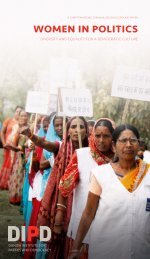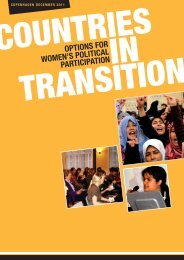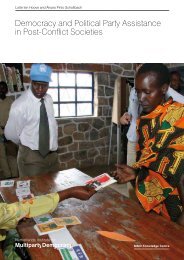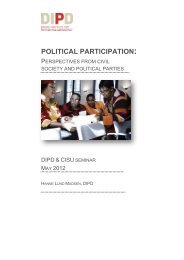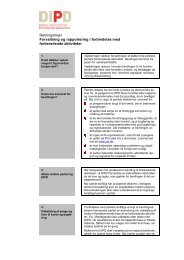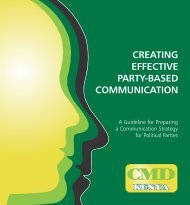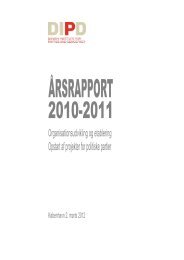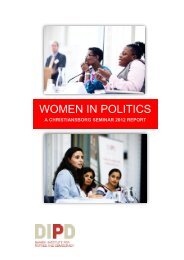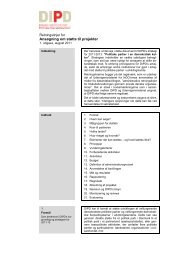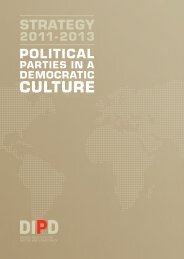Political Parties in Africa: Challenges for Sustained Multiparty
Political Parties in Africa: Challenges for Sustained Multiparty
Political Parties in Africa: Challenges for Sustained Multiparty
You also want an ePaper? Increase the reach of your titles
YUMPU automatically turns print PDFs into web optimized ePapers that Google loves.
International Idea<br />
Table 3.1: Percentage of the largest language group identify<strong>in</strong>g<br />
with the govern<strong>in</strong>g party <strong>in</strong> 12 <strong>Africa</strong>n countries<br />
No. Country Largest language groups Percentage identify<strong>in</strong>g<br />
with the govern<strong>in</strong>g party<br />
1 Namibia Oshiwambo 71.4<br />
2 Tanzania Swahili 56.1<br />
3 Malawi Chewa 49.6<br />
4 Botswana Setswana 45.5<br />
5 Nigeria Hausa 32.2<br />
6 Lesotho Sesotho 34.5<br />
7 Zambia Bemba 34.2<br />
8 Mali Bambara 33.7<br />
9 Zimbabwe Shona 31.3<br />
10 South <strong>Africa</strong> Zulu 29.8<br />
11 Ghana Akan 29.3<br />
12 Uganda Luganda 13.4<br />
Average 38.7<br />
Notes:<br />
1. Q: ‘Let’s th<strong>in</strong>k <strong>for</strong> a moment about the languages that you use. What language do you speak most at<br />
home?’. Note that dialects with<strong>in</strong> languages are not counted separately <strong>in</strong> this classification, hence<br />
‘Sesotho’ <strong>in</strong>cludes Sotho and S.Sotho. ‘Setswana’ <strong>in</strong>cludes Tswana. Groups less than 1 per cent of the<br />
sample are also excluded <strong>for</strong> the calculation of the ethno-l<strong>in</strong>guistic fractionalization (ELF).<br />
2. Norris and Mattes’ data are more elaborate, <strong>in</strong>dicat<strong>in</strong>g up to the seventh-largest ethnic group, as<br />
well as a munltitude of m<strong>in</strong>ority ethnic groups classified as ‘all others’.<br />
Source: Norris, Pippa and Robert Mattes, ‘Does Ethnicity Determ<strong>in</strong>e Support <strong>for</strong> the Govern<strong>in</strong>g<br />
Party?’, Afrobarometer Paper no. 26, March 2003, p. 9.<br />
One of the present authors, M. A. Mohamed Salih, reached similar conclusions <strong>in</strong><br />
his research on ethnicity and quasi-polyarchy (Mohamed Salih 2001), where he<br />
also <strong>in</strong>cluded some of the countries studied by Norris and Mattes (2003). Table 3.2<br />
complements the picture presented by Norris and Mattes (2003) <strong>in</strong> that it shows<br />
clearly that the back<strong>in</strong>g of their ethnic group—the dom<strong>in</strong>ant ethnicity—has won<br />
the political parties <strong>in</strong> question their majority, but also that the elections were fought<br />
not only on the basis of ethnic affiliation but also by secur<strong>in</strong>g alliances with and the<br />
votes of the smaller ethnic groups <strong>in</strong> the electoral district.<br />
Salih concluded, first, that although each political party has an ethnic base or is part<br />
of a pact of ethnic groups, ethnicity is more prom<strong>in</strong>ent <strong>in</strong> some countries than others.<br />
The manifestations of ethnicity also differ greatly. We can f<strong>in</strong>d examples of religious,<br />
regional and l<strong>in</strong>guistic manifestations, such as m<strong>in</strong>ority ethnic groups with<strong>in</strong> the<br />
Context



